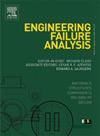Highly energy absorption capability of biomimetic thin-walled structures inspired by woodpecker beak integrated with turtle shell curvature
IF 4.4
2区 工程技术
Q1 ENGINEERING, MECHANICAL
引用次数: 0
Abstract
Energy absorbing structure is crucial for impact protection under complex loading conditions. This study proposes an efficient lightweight impact-protection structure with sinusoidal and circular thin-walled beams, inspired by the beaks of woodpeckers integrating with shells of turtles. The finite element simulations on compression and impact reveal that the structure undergoes progressive deformation as the amplitude increases. The analysis results show that both total energy absorption (EA) and specific energy absorption (SEA) are significantly influenced by the amplitude, with the maximum SEA reaching 6.75 J/g which is nearly 3 to 4 times higher than the conventional honeycomb structures. Additionally, the results also indicate that increasing the thickness of the structural walls can enhance the compression strength. However, this could lead to a higher total mass and reduced effective compression deformation, which in turn decreases SEA. This research offers a novel approach to designing lightweight protective structures for applications in energy absorption.
以啄木鸟喙为灵感,结合龟壳曲率的仿生薄壁结构的高能量吸收能力
吸能结构是复杂载荷条件下的冲击防护的关键。本研究提出了一种有效的轻型冲击保护结构,采用正弦和圆形薄壁梁,灵感来自啄木鸟的喙与海龟的壳相结合。压缩和冲击的有限元模拟表明,随着振幅的增大,结构发生渐进式变形。分析结果表明,蜂窝结构的总能量吸收(EA)和比能量吸收(SEA)均受到振幅的显著影响,比能量吸收最大可达6.75 J/g,是传统蜂窝结构的近3 ~ 4倍。此外,研究结果还表明,增加结构壁的厚度可以提高结构的抗压强度。然而,这可能导致总质量增加,有效压缩变形减少,从而降低SEA。该研究为设计用于能量吸收的轻质防护结构提供了一种新方法。
本文章由计算机程序翻译,如有差异,请以英文原文为准。
求助全文
约1分钟内获得全文
求助全文
来源期刊

Engineering Failure Analysis
工程技术-材料科学:表征与测试
CiteScore
7.70
自引率
20.00%
发文量
956
审稿时长
47 days
期刊介绍:
Engineering Failure Analysis publishes research papers describing the analysis of engineering failures and related studies.
Papers relating to the structure, properties and behaviour of engineering materials are encouraged, particularly those which also involve the detailed application of materials parameters to problems in engineering structures, components and design. In addition to the area of materials engineering, the interacting fields of mechanical, manufacturing, aeronautical, civil, chemical, corrosion and design engineering are considered relevant. Activity should be directed at analysing engineering failures and carrying out research to help reduce the incidences of failures and to extend the operating horizons of engineering materials.
Emphasis is placed on the mechanical properties of materials and their behaviour when influenced by structure, process and environment. Metallic, polymeric, ceramic and natural materials are all included and the application of these materials to real engineering situations should be emphasised. The use of a case-study based approach is also encouraged.
Engineering Failure Analysis provides essential reference material and critical feedback into the design process thereby contributing to the prevention of engineering failures in the future. All submissions will be subject to peer review from leading experts in the field.
 求助内容:
求助内容: 应助结果提醒方式:
应助结果提醒方式:


